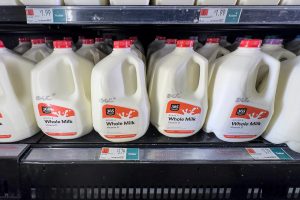
For example, farmers are reporting they will be seeing from $0.90 per hundredweight up to $2.50+ per hundredweight market adjustments which will be deducted from the September milk checks and continue through the end of the year.
A copy of one letter was sent to the American Dairy Coalition. In it, the cooperative cites rising costs and insufficient “make allowances” as one reason for the new deduction. A recent cost of processing study done for USDA by Dr. Mark Stephenson of UW Madison indicates that the current make allowances that are already built into the USDA end-product pricing formulas are collectively about $1.00 per hundredweight short of covering costs to make the bulk cheddar, butter, nonfat dry milk and whey that are surveyed monthly for the USDA pricing formulas.

On the other hand, the cost of processing report described the difficulty in extracting the costs related to only those four bulk commodities because most dairy plants today make a range of products that are not included in the end-product pricing formulas. Those other products represent substantially more milk and may be sold by processors at higher prices without increasing the price they, in turn, pay to their farmers – this appears to allow additional processor income to cover costs.
We are learning that hearings could soon be requested to raise the processor make allowances that are embedded in the milk pricing formulas, which, if approved, could reduce the prices paid to dairy farmers.
We understand that processors are facing inflation in their input costs. Farmers are also experiencing intense inflationary pressure on their operations too. The difference is, the farmers’ cost of production is not considered in the milk pricing formulas – at all.
These milk check deductions appear to be a way to shift rising costs over to farmers through mailbox milk check deductions.
Milk cooperatives can do this even if they are participating in the federal milk marketing order revenue-sharing pools. The law recognizes the entire cooperative as a producer, so when they pay their farmer members, they do not have to pay the minimum federal order price. They can adjust it by re-blending what they receive from the pool and from sales according to their own utilization of milk, and they can add deductions to cover costs that they determine are not being extracted from their market sales. Proprietary plants, on the other hand, must pay the minimum price if they participate in the federal order pool.
Currently, there are several divergences occurring between different formula products and milk use classes. Plus, farmers recently have seen a $1 to $2.00 reduction in their Class I fluid milk price due to a legislative milk pricing formula change made in the last Farm Bill without a formal Federal Milk Marketing Order hearing and without most farmers knowing much about it until it was signed in to law. Over the past 42 months since this change was implemented, the net loss to all dairy farmers grew to more than $887.6 million. This is like a $0.63 deduction on all Class I milk pounds sold over the course of nearly four years or a $0.20 per hundredweight deduction on the blended price for all milk sold for all uses over that time. This formula has also performed poorly under market stress, creating dysfunction in the Federal Orders with further negative impacts on mailbox milk prices and the performance of purchased risk management tools.
From the processor side, they too are conflicted with other aspects of the milk price formulas because of divergences between barrel cheese prices and block cheese prices and in the value of fat used in making butter vs. cheese.
Discussions about federal milk pricing formulas have been ongoing, and there will be an American Farm Bureau national stakeholder meeting in Kansas City in two weeks about possible future reforms.
ADC’s position is straightforward. We believe these ‘processor make allowances’ that are embedded in the pricing formulas should be put on hold until the milk pricing change that was made in the last Farm Bill is thoroughly vetted through a side-by-side comparison with the Higher of Formula at a Federal Milk Marketing Order hearing, or is reversed. The reason we have taken this position is because farmers are already on the short end of the stick. They are the last rung in the supply chain ladder, and they have no one to go back to extract a “make allowance” to cover their rising inflationary costs.
If the make allowances are elevated without addressing these other concerns, the mailbox price will be reduced to the farmer, and there is nothing to prevent processors from re-blending and the potential for additional deductions on top.
Only Class I beverage milk is required to participate in the federal milk marketing order pools. So, the other side of this issue is the pooling revenue sometimes goes negative when these price divergences happen and processors take higher value manufacturing milk out of the revenue sharing pools to increase profitability, but they don’t necessarily equalize the additional revenue with their dairy farmers.
ADC’s bottom line is this: We are navigating uncharted waters with a system that is antiquated, not nimble and a convoluted milk pricing scheme in which the actual dairy farmer’s need to have a clear and conclusive voice. That’s why ADC has spent so much attention and time on this issue with webinars and forums and teleconferences and communications to get farmers informed and at the table to secure their future viability.

























